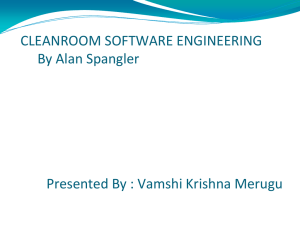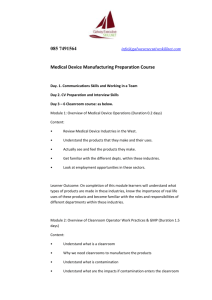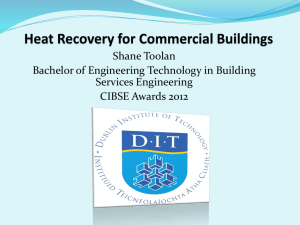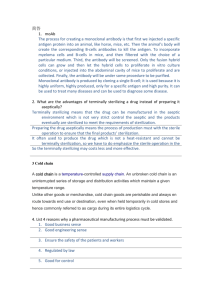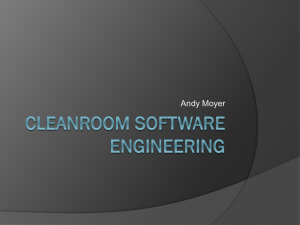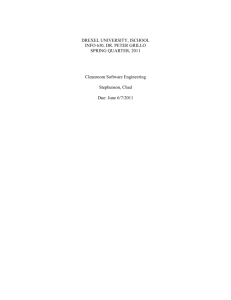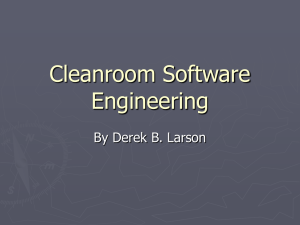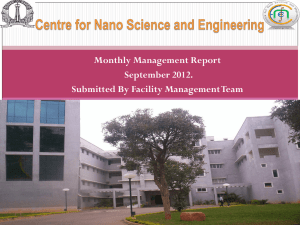The Bottom Line on Buying a Cleanroom System By: Rick Dobson
advertisement
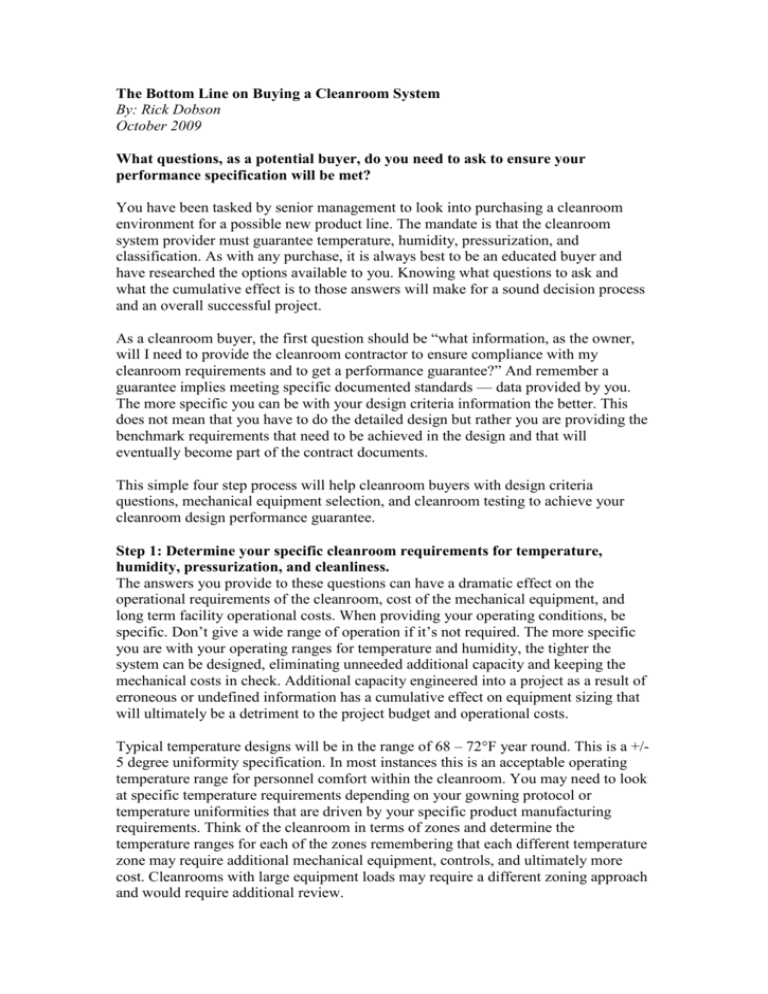
The Bottom Line on Buying a Cleanroom System By: Rick Dobson October 2009 What questions, as a potential buyer, do you need to ask to ensure your performance specification will be met? You have been tasked by senior management to look into purchasing a cleanroom environment for a possible new product line. The mandate is that the cleanroom system provider must guarantee temperature, humidity, pressurization, and classification. As with any purchase, it is always best to be an educated buyer and have researched the options available to you. Knowing what questions to ask and what the cumulative effect is to those answers will make for a sound decision process and an overall successful project. As a cleanroom buyer, the first question should be “what information, as the owner, will I need to provide the cleanroom contractor to ensure compliance with my cleanroom requirements and to get a performance guarantee?” And remember a guarantee implies meeting specific documented standards — data provided by you. The more specific you can be with your design criteria information the better. This does not mean that you have to do the detailed design but rather you are providing the benchmark requirements that need to be achieved in the design and that will eventually become part of the contract documents. This simple four step process will help cleanroom buyers with design criteria questions, mechanical equipment selection, and cleanroom testing to achieve your cleanroom design performance guarantee. Step 1: Determine your specific cleanroom requirements for temperature, humidity, pressurization, and cleanliness. The answers you provide to these questions can have a dramatic effect on the operational requirements of the cleanroom, cost of the mechanical equipment, and long term facility operational costs. When providing your operating conditions, be specific. Don’t give a wide range of operation if it’s not required. The more specific you are with your operating ranges for temperature and humidity, the tighter the system can be designed, eliminating unneeded additional capacity and keeping the mechanical costs in check. Additional capacity engineered into a project as a result of erroneous or undefined information has a cumulative effect on equipment sizing that will ultimately be a detriment to the project budget and operational costs. Typical temperature designs will be in the range of 68 – 72°F year round. This is a +/5 degree uniformity specification. In most instances this is an acceptable operating temperature range for personnel comfort within the cleanroom. You may need to look at specific temperature requirements depending on your gowning protocol or temperature uniformities that are driven by your specific product manufacturing requirements. Think of the cleanroom in terms of zones and determine the temperature ranges for each of the zones remembering that each different temperature zone may require additional mechanical equipment, controls, and ultimately more cost. Cleanrooms with large equipment loads may require a different zoning approach and would require additional review. Humidity requirements are most often product driven and can cover a wide range of operation. The biggest problem I see is over-specified humidity control due to the unknown requirements of the manufacturing process. Humidity control can add a tremendous amount of money to your design and operating costs, so again be as specific as possible and understand the cost implications of specifying a humidity range that is not needed. For example: Ambient to 60% RH maximum is a standard design with RH control utilizing the air handler cooling coil. 60% RH year round means summer conditions can be maintained utilizing the cooling coil; winter conditions will require additive humidification. 30% to 60% RH year round is considered a wide range operation and requires the room to operate within these conditions at anytime. The lower RH condition will drive the design to utilize specific dehumidification beyond that of the cooling coil and additive humidification for the higher RH levels. If your product is extremely temperature or humidity sensitive you may have to tighten the uniformity requirements. Pressurization cascade can be positive or negative to the surrounding ambient area dependent on the specific manufacturing requirements. The pressurization requirement is a factor of the products manufactured within the cleanroom and also personnel safety. To maintain pressurization will require conditioned make-up air at a percent of the total airflow requirement to offset exhaust and designed leakage rates. Negative pressure cleanrooms are typically designed with filtered returns such as bagin/bag-out filtered return air or as once through systems and are the most expensive to operate because all of the conditioned cleanroom air is fully exhausted continually. Classification requirements are again most often product driven through approved manufacturing guidelines. You will need to research your specific manufacturing cleanliness requirements to create your user requirement specification (URS). When specifying your cleanliness levels make sure to indicate your testing requirements 1) at rest, 2) in operation, and 3) other. With most cleanroom operations, the majority of particulate is generated by personnel working within the room. It’s important to review the number of people that will be working in the cleanroom, the gowning protocols, and the number of people per shift or the number of hours of operation per day. It’s not uncommon for room cooling loads to actually drive the air change rates within a cleanroom. If your manufacturing guideline recommends 60 ACH and the design engineer comes back with a higher air change rate, it’s probably due to the room cooling loads — but do ask for an explanation. How do you control temperature/humidity/pressurization and what data do you need for your validation process? Control systems can go from basic to complex in a hurry and the cost escalation can be alarming. As an owner, you need to discuss what type of control and monitoring will be required with your manufacturing group. A stand alone control system is normally the least expensive with localized indication of temperature, humidity, and pressurization. These controls can accommodate a 4-20 ma output for localized alarm indication. At the other extreme are full building management systems (BMS) with fully validated points of control, remote monitoring capability, and compliance with Title 21 Code of Federal Regulations (21 CFR Part 11). Step 2: Develop a dimensioned layout drawing of the cleanroom area, paying specific attention to your product flow, personnel flow, process equipment layout, process utilities, electrical requirements, and maintenance access. Remember to include personnel and material airlocks as required. Again, this is an area where you need to do your homework. More often than not you see cleanrooms that were not designed for adequate product and personnel flow creating manufacturing problems along with operational problems when return air drops are blocked with materials. Ceiling heights are often driven by the process equipment within the room and can vary widely depending on the manufacturing process. The cost of a cleanroom is largely in the mechanical equipment. The airflow requirements (CFM) are determined by the volume of the room which is a direct correlation of the room height (length x width x height = ft/3 of volume). To minimize the cleanroom volumetric airflow requirements, keep the ceiling levels to a minimum and utilize soffit details when possible. Return air details are typically utilized in Class 10,000 (ISO 7) and cleaner environments. Remember to allow dimensionally for return air locations in your overall space planning layouts. The quantity of low wall returns will ultimately be determined by the cleanroom classification and room sensible/latent load requirements to achieve the needed air changes per hour (ACH) and temperature uniformity. Allow enough room in your layouts to keep the return air depth such that the feet per minute velocity (FPM) is within good engineering practice standards. Going outside the recommended velocities can result in poor room performance and excessive air noise. Architectural finishes and clean details are typically driven by the specific manufacturing process. A good reference to utilize is the ISPE Baseline Pharmaceutical Engineering Guide. These types of reference materials will guide you in the accepted materials of construction. Ensure that all of the architectural finishes are compatible with your cleaning solutions and will withstand your long term cleaning protocols. Step 3: Review your mechanical support services and determine your preference on providing conditioned air to your cleanroom. It’s also important to consider the location of the mechanical equipment in relation to the cleanroom. If you have an existing building chiller and the chiller capacity is adequate and the chilled water temperature and GPM work for the design, this may be a possible area for cost savings. One thing to remember is that the cleanroom is now tied to a building chiller and if the chiller goes down so will the cleanroom. A dedicated mechanical system packaged chiller, packaged DX (Direct Expansion) system, or split system has the advantage of being a standalone system and not tied to the existing HVAC system, however, the upfront and long term operational costs are generally higher. Air handlers are available in standard configurations which might again be an area of savings but typically cleanroom air handlers require custom construction materials, CFM requirements, pre-heat, re-heat, and dehumidification. HVAC equipment locations for cleanrooms can be located indoors or outdoors. Indoor air handling units (AHUs) are less expensive than equivalently designed outdoor equipment. The down side to indoor equipment is space allocation and possible noise implications. Outdoor units are a standard design but will require curbs to be roof mounted and pads for ground located equipment. If you have a leased building, the location of the equipment needs to be discussed with the owner of the building as most leased spaces require all equipment to be removable at the end of the lease. Step 4: Finalize your user requirement specification (URS) to be presented to the cleanroom contractor. You don’t want to limit the ability of the cleanroom engineer to design the cleanroom; however, you do need to provide your design criteria in a clear and concise document that leaves no room for interpretation. As part of the specification, require a copy of the turn-over package and copies of all test reports as noted below. Provide a written specification with the design criteria for temperature, humidity, pressurization, and cleanliness. Provide a dimensioned layout drawing showing your process flow. Be prepared to discuss your HVAC preferences and equipment locations. Provide any personnel, process, and exhaust sensible and latent loads. Provide a preliminary control strategy and your monitoring requirements. Provide a detailed testing strategy and as a minimum include: Temperature control and uniformity Humidity control and uniformity Pressurization verification Particulate counts Request copies of the Installation Qualification and Operational Qualification reports. Request site test reports from a certified testing and balance company. Request copies of the HEPA filter factory and site certification reports. Request a list of each of the HEPA filter serial numbers and their installed locations within the project. The narrative above is a brief example of the initial information required to start the design for a cleanroom environment. There are additional design factors that need to be considered before entering into the detailed design phase. Your cleanroom contractor will ultimately need to review the constructability of your design criteria requirements to provide a performance guarantee. Rick Dobson is Director of Pharma Sales for AES Clean Technology in Suwanee, Georgia, and can be reached at 678-804-0260 x12 or rdobson@aesclean.com.
